 Describe your very first story in a sentence or two and tell us the genre.
Describe your very first story in a sentence or two and tell us the genre.
Mine was a children’s book.
Bull-headed squirrel learns the importance of family after a lightning storm traps him inside a fallen tree.


It’s been awhile since I looked into the current details on creating an audio book. With self-publishing, authors have options these days and I have created my own audio book after a publisher forgot to add those subsidiary rights to the contract. It was a great learning experience and I worked through ACX, which was the first and only way to self-pub in audio back then. These services can merge service providers (voice actors/narrators/production, distributors, & authors) and provide stock contracts between the parties and a means to communicate and create an audio book.
Nowadays, there are more service providers and an author can even consider making their own recording. The first step is to confirm you have your audio subsidiary rights before you proceed with creating an audio book. But once you have done that and your rights are available, an author has options to produce and distribute their own audio book.
Here’s what I learned:
Below are a few service providers for Audio Books to get you started. These are platforms that bring authors together with the people & services you will need.
SERVICE PLATFORMS
ACX.com is a marketplace that connects rights holders (authors, publishers, agents etc) with narrators and producers to enable audio book production. It’s an Amazon company and audio books produced through the site are sold on Amazon, Audible and iTunes.
FindawayVoices.com – can help match you with a narrator, or you can publish your own files separately. They have a royalty share option as well as a pay per finished hour contract. The big difference here is that you can set your own price AND set the price separately for retail and library markets. Plus you can use their Authors Direct app to sell audio direct to listeners.
KoboWritingLife – if you use Kobo to create your work, your audio book is eligible for different kinds of promotion. Kobo sells audio books to its readers, but Kobo also works with its sister company, Overdrive, for library distribution, as well as having distribution deals with Walmart and other companies. You can reach the same markets through Findaway but the additional promotion may make it worthwhile to go direct to KWL.
Do a Combo – A new author might choose to do a royalty split with a narrator/production company. It’s generally a more affordable option, but as far as opting for a wider distribution, you can choose a combo. You may choose to go through ACX but with a non-exclusive contract for Amazon/Audible distribution. You may find wider markets in Findaway Voices. NOTE: If you already have an exclusive royalty split agreement through ACX, you may decide to change that to non-exclusive at the time of renewal. You can download your audio file from ACX and transfer it to Findaway Voices when you have the rights to do it.
Whatever you opt to do, be sure you understand how your audio book will be distributed and how your royalties will apply over the long term.
AUDIO PRODUCTION
You have two choices for audio production. You can choose to record the book reading yourself OR you can hire a professional (and a service provider) to do it for you. Speaking as a former high school drama student, it’s tempting to try a recording, but I know better. Despite the benefits of an author knowing the material and hearing the dialogue in their mind, it takes a special kind of voice actor to pull off a great audio book. Merely reading the words is not enough.
For those of you willing to try it, here’s what you would need to do your own recording.
Depending on your budget, the equipment and software could be as little as $200, but the biggest investment will be in the time it will take you to not only produce a recording, but the effort to edit in post-production. According to Audible, an industry professional reads approximately 9400 words per hour. If your book is 90,000 words in length, it will take 9.57 hours to produce a recording, minimum. This is NOT a speed reading exercise. To be conservative, you should count on doubling that time to account for retakes, breaks between sessions, and allowing your voice time to recuperate.
I found this great link on How To Make an Audio Book: A Do It Yourself Guide. This is a detailed guide if you are serious about doing your own audio book. It goes into specifics of the equipment you should consider from your computer hardware to microphone, to recording environment, and software. The article goes into depth of one person’s experience and what they specifically used. Very cool. It even goes into suggestions on the opening and closing credits and talks about the image used for the distribution cover. There are also specifics on how to edit. Great stuff.
PROMOTION
FOR AMAZON/AUDIBLE – First off, it’s important for your audio book to appear on the book pages for your other formats. It’s not only important for readers to find all your formats, but if your audio is not linked in all formats, the Whispersync technology (a product of Amazon and Audible) won’t be synchronized between your ebook and audio. That’s a nice convenient feature for readers/listeners. PLUS, once Whispersync is available, the reader can purchase the audio book at a reduced price.
If your audio book is shown on an orphan page where it is not merged with the other formats of your book, send an email to KDP-support@amazon.com & include the links to the Amazon pages for all the formats.
SOUNDCLOUD – This is an app you can get on Google Play/Store that will feature an audio clip of your book once you become a member. It allows you to promote on social media and include a sound clip link to give readers as a sample. A sound clip can be an interesting way to attract new readers if you cross post it on social media and have it on your website book page.
Where to Market Your Audio Book on Facebook – There are a number of Facebook groups you can query to find sites to subscribe and promote your audio books. Here are a few:
Audio Book Addicts 6000+ members
Audio Books! Over 3 Million followers
Aural Fixation Over 3 Million Followers
Other AudioBook Promo Sites:
Audiobook Jukebox – submit your audio book for a review. Reviewers can request your audio book for a review, similar to Netgalley.
Audio Books Unleashed – You load your promotion codes for your freebie giveaways on the listing page, and the site gives one to each listener requesting the audio book.
AudioBookBoom – This is a site that’s the equivalent of BookBub but for audio books.
Audio Book Marketing Resource List – This is a huge list of sites where you can have your audio book reviewed or promoted. Tons of links and includes more Facebook gand Goodreads groups focused on audio books.
Paid Advertising:
BookBub has ChirpBooks, which is an audiobook promotion service for limited time price cuts. They are partnered with Findaway Voices because other distributors don;t allow you to set or change your prices for an audio book. You can sign up to be on the wait list on this page.
You can pay to advertise your audio book in AudioFile’s Indie Press Showcase.
I was amazed at all the new things online for authors who might want to retain their subsidiary rights for audio books. I listen to audio book almost every night. It’s a relaxing way to fall asleep – like someone reading you a bed time story in the dark. I also love that retailers, like Amazon, give readers a discounted price for the audio book addition to your library. I’ve gone back to my reading list to see if some of my fav authors have audio book sold at a good price. Things have definitely changed for the better for audio books.
For Discussion
This post is only the tip of an iceberg for all the resources available for audio books and an author’s options. If you have any audio book experiences or resources to share, please put them in your comments.
Share some of your favorite voice actors/narrators.
Share some of your favorite audio books.
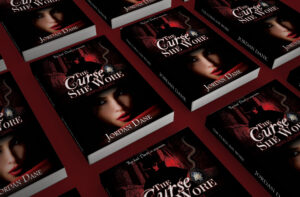
The Curse She Wore – Available for Pre-Order – Releases Feb 10, 2020.
Trespassing on Fate’s turf comes with a price for two broken people–a price they never see coming.
It’s time for my final curtain, dear friends. This is my last official post for TKZ. It’s with a heavy heart that I write this, because I’ve had a blast with you the past several years.
TKZ was the first and only group blog for which I’ve written regularly, and I couldn’t have chosen a better one. I can’t think of a more experienced group of writers writing about writing on the Internet. While many other group blogs have become weighed down with self-promotion and infighting and prima donna grandstanding, TKZ has only gotten better with time.
You, dear readers, are our better halves. You’re talented and curious and smart. You make it a pleasure to show up–whether it’s to post or join in the comments. Please give yourselves a big round of applause.
It’s often a challenge for me to come up with blog topics about writing that I think will interest you. My interior life is chaotic, and writing fiction is still a mystery to me after three decades of writing. When I finish writing a book or story, the memory of how I did it dissolves with time like Kool Aid mix in water–and nearly as quickly. It’s tough to delineate a process that I can’t precisely recall. While I am a person of a certain age, it’s not that I’m going dotty. It’s just the way my ADHD brain works. I can hyperfocus on something so that it becomes a delicious experience that engages my senses so fully that I find it difficult to return to reality. It’s a dreamlike state, and, like a real dream, it dissipates and disappears. When things are going well, a dozen pages of writing is left behind. The challenge is dodging all the shiny objects that seem to throw themselves at me when I’m trying to get back to the dream again.
If it sounds like I’m telling you that writing is magic that can’t be taught, I promise I’m not. I attended writing classes and workshops during the first six or seven years I was writing. (And I have to tell you that if you pay attention to the craft and critique pages here, and you write regularly, and read, you will get a solid writing education without paying a dime. Just sayin’…) Writing is not magic. It’s a combination of art and craft.
So, I hope you’ll forgive me for all the posts I didn’t write about how to plot, or create a character, or remind you to number those pages. (Seriously, Manuscript Rule 1 is number your pages!) We all have different strengths, and different gifts.
You know I love a list. Here’s a list of a few thoughts about writing and the writing life I’d like to leave with you.
— Read indiscriminately. Read the stories that you know will please you, and read stories and writers that will challenge you. Read out of your preferred genre and your culture and your comfort zone. Good writing is everywhere. Learn from it.
— Write bravely. I won’t lie. Brave is hard. The more of yourself–your feelings, your experiences, your ideas, your imagination–you put in your work, the better it will be. It may seem that both publishers and our contemporary society are currently offering writers very narrow lanes in which to write. It’s tough to be brave when you’re feeling pressured and walled in. Be brave anyway. That’s where your best work lies: beyond the walls.
–Let yourself be envious, then let it go. Too much envy is poisonous, but it’s a totally normal feeling. If you feel it, that’s okay. Let it motivate you to write better, be better. But use it and let it go before it turns on you. The phrase love and light sounds like the stuff of an SNL skit, but it’s kind of useful. Pile coals of kindness on the heads of those who make you itch with irritation. Their journey is not your journey, so keep your eyes on your own paper and do your own work. (Did I get enough platitudes in that paragraph?)
–Don’t be a dick. If you achieve any kind of success–from being the first in your writing group to sell a story, to being the only one at a table full of established writers to have made the bestseller lists–don’t be arrogant. Retain (or cultivate) some humility, if only because you never know when you’ll get surpassed or taken down, or by whom. Otherwise, it’s just a good idea to be nice. Cheer others’ successes. It’s true that someone might forget that you offered them congratulations on their Facebook page, but they won’t ever forget if you only ever talk about yourself.
–Don’t bore your reader. If you’re writing and you find you’re getting bored, stop what you’re doing immediately and try something different. If you’re feeling bored, chances are your reader would already have wandered off.
–Publishing is a crapshoot, and there’s an element of luck involved. Raise your odds by submitting (to an agent or publisher or beta reader) your best writing, packaged as a clean manuscript, and ask for help, advice, or representation in the most polite and charming way possible. Keep in mind that there are a huge number of not-very-well-written books alongside terrific books released every week. Just because you get a rejection doesn’t mean your writing is bad.
–Write what brings you joy. Or scares your pants off. Or makes you cry in a good way. That way lies authenticity (always good) and personal fulfillment (even better).
That’s it. I’m done. In Frank’s immortal words: I did it my way. Thank you, thank you, thank you for your kind attention. Stay in touch. Write like the wind! xx Laura
By Debbie Burke
Today I’m delighted to chat with bestselling authors Kat Martin and L.J. (Larry) Martin, who’ve been together for 34 years. Between them, they have written well over a hundred novels.
Kat has written more than 75 historical and romantic suspense novels that have sold many millions of copies all over the globe. Larry crosses multiple genres, with bestselling westerns, thrillers, and nonfiction. He is also a founder and former owner of Wolfpack Publishing.
Here’s the inside scoop from Kat and Larry on their successful, long-lasting relationship.
DB: For most households, one author is quirky enough. How do two authors married to each other make it work?
Kat: Actually, it has some advantages. We have the same friends, travel to the same conferences, are interested in a lot of the same subjects. We also understand the frustrations of being a writer, which are difficult for a non-writer to understand.
Larry: Ditto to Kat’s answers, plus we can read each other’s work and comment. For instance one time she was reading some female dialog I’d written and then drew a little mustache in the margin…I got it, my lady sounded like a dude.
DB: You met each other while working in the real estate industry. How did you each make the huge career change from real estate to writing?
Kat: Larry had already written a historical novel when we met. He continued to work while I wrote my first book and we ended up selling both novels within six weeks of each other.
Larry: I had a giant year in the R.E. biz and never wanted to work that hard again. We had a little financial cushion, and needed it, and Kat was enthralled with my writing and said, “Hell, I can do that.” And did, far better. We’d always been avid readers, which is the basis of great writers.
DB: You are both exceptionally prolific authors. Do you have systems or routines for keeping up high production?
Kat: I don’t have kids, which gives me a lot of free time. Larry’s boys are grown. So that gives us a real time advantage. Also, we like what we are doing so mostly we would rather be writing than anything else. Well, I do enjoy traveling, staying in nice hotels and eating in gourmet restaurants. But we manage to work that in.
Larry: It’s productive to have “in-house” competition and an example to follow. Kat’s a voracious worker. I’m distracted by yard work, garden, photography, hunting…but her dedication always pulls me back. And both of us love to write.
DB: Do you brainstorm with each other on story ideas? Can you describe the process?
Kat: Larry writes his own books, his own way. No input from me. I appreciate his help with plotting and he also reads my action scenes and gives me input. Other than that, we pretty much work separately.
Larry: Neither of us slows down enough to get much input from the other. I help her occasionally with the male aspect: fistfights, firearms, survival, but that’s about it. I’m also preoccupied with publishing nonfiction, and enjoy that part of the biz.
DB: You often combine travel with research. This may be a chicken and egg question but do you visit locations with a plot already in mind, or do story ideas spring out of new places?
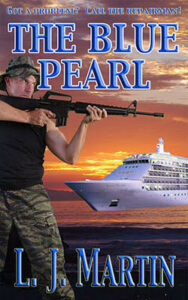 Kat: A little of both, I think. Sometimes we go places because one of us is working on a story. Sometimes when we are traveling a new idea comes from the experience we are having at the time. Larry just finished a novel called The Blue Pearl, a high action thriller set around a cruise ship being taken over by terrorists. Our cruise was already planned. The story came to him before we left and the cruise helped with his research.
Kat: A little of both, I think. Sometimes we go places because one of us is working on a story. Sometimes when we are traveling a new idea comes from the experience we are having at the time. Larry just finished a novel called The Blue Pearl, a high action thriller set around a cruise ship being taken over by terrorists. Our cruise was already planned. The story came to him before we left and the cruise helped with his research.
Larry: Most action books are a quest of some kind so the cruise was ideal with the addition of some really bad guys in exotic locations. I was able to interview the captain and security people and go everywhere on board other than the engine room. My prior thriller, The K Factor, was set primarily in North Korea and trust me, I didn’t go, and the cruise and great sights and wonderful restaurants in France, Spain and Portugal was more fun than researching lots of North Korean trials and tribulations…as much as I enjoy research.
DB: Describe a typical work day for Kat.
Kat: My day starts around 7 a.m. I enjoy my morning till around nine o’clock, when we either head to the gym for an hour, or I start going through email and doing some promotion. I like to be writing by 11:00, no later than noon, then write till the end of the day. After that I do some Facebook and a little more promo, then pour myself a glass of wine and relax for the evening.
DB: Describe a typical work day for Larry.
Larry: I hit the machine early, usually by six at least. When I smell the blood sometimes by four as I can’t sleep as my mind is plotting. Cup of coffee, sweatsuit, and I write until it’s time to shower and three days a week hit the gym to keep the brain blood flowing, then back to the word processor. Often in the P.M. I’m in the garage or outdoors, but I’ve already got my eight or ten in.
DB: How do you balance your individual creative idiosyncrasies in a long-term relationship?
Kat: Mostly he does his thing; I do mine. We overlap at the end of the day. He has a lot more diversified interests than I do. I’m fairly well consumed by my writing. Though currently, I’m on a remodel project for our new winter home, which has been agonizing and exhilarating.
Larry: It’s more than merely nice to have a beautiful, intelligent, woman with like interests seldom more than one story away. Most of the idiosyncrasies are left in characters in our books. We both love to cook, love a good glass of wine, love good dramas on TV or the theater, and each other’s company. What could be better?
DB: Is there anything else you’d like to share with readers of The Kill Zone?
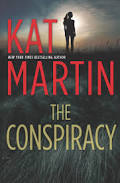 Kat: I’ve got more Maximum Security novels coming out, including a new novella called Come Daybreak, which is one of my personal favorites. I’m hoping readers will be on the lookout for the books and that they enjoy them.
Kat: I’ve got more Maximum Security novels coming out, including a new novella called Come Daybreak, which is one of my personal favorites. I’m hoping readers will be on the lookout for the books and that they enjoy them.
Larry: And I’m supporting Wolfpack Publishing, a company I co-founded and sold to my former partner, who still publishes my Westerns, and now that my non-compete has expired I’m into another aspect of publishing. No one does a better job with Westerns, and other fiction, than Mike Bray. Buttonwillow Books, my new effort, publishes my nonfiction and some for others. I’m currently enjoying publishing educational books by T. Michael Traser, an internationally recognized educator and a friend. If you’re a teacher, particularly one with English challenged students, check out the series ESL – Fun Games for the Classroom. Immigrant children who don’t master English are destined to be trapped in barrios and enclaves, and that’s not a good thing. And while you’re at it grab a copy of Rugged Trails, my latest western, suitable for young adults. Thanks for taking the time to chat with us.
~~~
Thank you, Kat and Larry, for opening up about your writing lives to TKZ readers.
Check out Kat’s books at katmartin.com and Larry’s books at ljmartin.com
~~~
3 Books for 3 Bucks – Special sale February 7-14, 2020. Debbie Burke’s thriller series is only $.99 each. Click on title for “buy” link.

I am posting my first page critique to assist Clare who is in Australia with personal family business. My first critique in 2020, I hope you’ll enjoy THE WILDFIRE PATHOGEN. Very timely with the Coronavirus out of China. Let’s sanitize our hands and read on. My comments will be on the flip side.
The Wildfire Pathogen
Even through six inches of solid acrylic, Conrad Jurek could see the monsters moving inside the box.
They were no more than grainy mists inside individual test tubes. Those mists swirled with each jolt of the plane as it powered through pockets of turbulence. Almost as if the bumpy ride irked them.
Jurek reached into his sage-colored flight suit, pulled out a pen, and began to jot notes on his clipboard. The acrylic box was a four-by-six foot transparent crate mounted on a hardwood dolly. A locking mechanism the size and weight of a manhole cover sat on top. He’d seen the same tamper-proof device protecting the innards of nuclear warheads.
The monsters inside could do far worse than mere firecrackers.
Six tubes hung suspended below the locking device like bullets chambered in a revolver. Each finger-length container held twenty grams of orthohantavirus, a solid mass of viral matter dried into particles as white and delicate as baby powder.
Yet each cylinder of glittering borosilicate glass held enough pathogenic material to kill several million men, women, and children.
A beefy hand came down on Jurek’s shoulder. He suppressed his instincts and allowed the hand to turn him around. A man wearing a black uniform with the word SECURITY stenciled across the front scowled at him before growling two words.
“Back off.”
Jurek held up the clipboard. “I’m supposed to do a load check mid-flight.”
“No one’s supposed to come close to the package.” The guard’s eyes flicked to the name tag at the chest pocket. “If I were you, Corporal Witkowski, I’d leave. Now.”
Two more security men stepped into view on the opposite side of the box. Jurek considered them for a moment. Under his flight jacket, a 9mm Beretta Nano hung snugly in a holster. The weapon was still warm from when he’d shot Witkowski and taken the airman’s uniform off the hanger.
No, he thought to himself. Stick to the plan.
Jurek turned away and went up to the cockpit. He locked the door and took the empty co-pilot’s chair. The pilot glanced over with a raised eyebrow. His uniform’s tag also bore the name of a man murdered in the last two hours.
“I’m familiar with the outer locking mechanism,” Jurek confirmed. “We go forward as planned, Doctor Isenhoff.”
“Good,” came the reply. “Get your oxygen mask ready.”
With that, Isenhoff reached out and flicked a single switch on the flight panel.
FEEDBACK
SUMMARY – Great place to start. This time it’s not SNAKES ON A PLANE. It’s monsters in a vial. We are already in the middle of the action with plenty of mystery and intrigue to keep turning the pages. The author sticks with the action without slowing the pace with backstory. There’s time for explanation once the reader is pulled in. At the end of the 3rd paragraph, the author draws the reader in tighter in describing the tamper proof canister and compares it to the protection on a nuclear warhead. Nicely done. And it got my attention when the author described a nuke to “firecrackers” compared to the monsters on the plane.
I also liked that the author had patience to let the reader discover that Jurek committed murder to get on the plane, wearing a dead man’s uniform. At this point, we aren’t sure if Jurek is trying to stop a deadly pathogen attack by hijacking the material from villains or if he plans to steal the deadly virus to commit his own attack. Great set up with plenty of mystery to unravel.
I especially like how the author had Jurek accosted by security and he had to restrain his instincts to fight the man off. He’s got more up his sleeve (a plan) and that’s when we find out that Jurek killed to board the plane. Nice touch, author.
Then a stroke of genius to have Jurek working with the pilot – a doctor presumably familiar with the pathogen – who is also a pilot. Jurek and Dr Isenhoff are in it together. And there’s a hint that there’s a reason Jurek went to check out the dangerous cargo, to determine if he knew how to break into the canister. Something bad is about to happen that involves oxygen masks. At this point, we don’t know who the protagonist is, but we have a great start.
TITLE – I like the reference to “wildfire.” We all know what that could mean in terms of spreading fast and the word “pathogen” is timely and medical. Only the author knows if there are other titles that could establish the critical danger in a better way, but I would be happy taking this title to a publisher. It’s more than a working title, in my opinion.
NIT PICKY – At the start of paragraph 3, I spotted a pet peeve of mine. I like a strong sentence with tight wording. The words “began to” are unnecessary. It would be better to say “…and pulled out a pen to jot notes on his clipboard.”
Jurek reached into his sage-colored flight suit, pulled out a pen, and began to jot notes on his clipboard.
Great job, anonymous author. There’s action and I’m intrigued. I would definitely keep reading. Okay TKZers, please leave your comments and provide feedback to this brave author. (Safe travels, Clare. We missed you.)
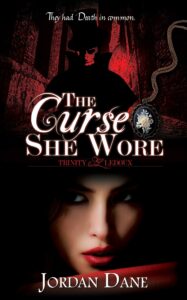
The Curse She Wore – Coming Feb 10, 2010. On presale now.
Trespassing on Fate’s turf comes with a price for two broken people–one they will never see coming.
by James Scott Bell
@jamesscottbell
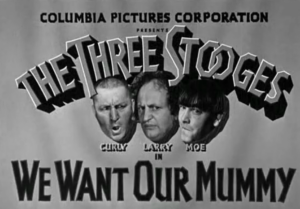 There are times when I need ten minutes of The Three Stooges. You know what I’m talking about. You’ve spent a long day writing some tough pages. Or you were bottled up in your cubicle at work, untangling your boss’s mess. Or maybe you were caught up in the latest news cycle, and you find yourself neck deep in the blues.
There are times when I need ten minutes of The Three Stooges. You know what I’m talking about. You’ve spent a long day writing some tough pages. Or you were bottled up in your cubicle at work, untangling your boss’s mess. Or maybe you were caught up in the latest news cycle, and you find yourself neck deep in the blues.
That’s what the Stooges are for. You don’t have to think. In fact thinking is precisely the wrong thing to do when watching the boys.
Now, I know the Stooges are not everyone’s comedic cup o’ noodles. Moe is often hard to take. Anything could set him off and get you a slap in the face or, worse, two fingers in the eyes. I had my run-ins with bullies as a kid, so Moe always made me uncomfortable (in real life, Moe Howard was a delightful man—who I met—and a great storyteller about the film business and the history of the Stooges).
But there is always Curly to save the day by giving us a nice, hearty belly laugh. (When Curly suffered a stroke in 1947, he was replaced by his and Moe’s real brother, Shemp. Most of my kid contemporaries didn’t like Shemp, but I did. While no one could ever replace Curly, Shemp is funny in his own way.)
Anyway, the other day I was in need of a respite from brain work and went to a Stooges short I’d recorded on the telly. It was We Want Our Mummy (1939). As you might guess, it’s about the boys, playing detectives, going to Egypt to try and find a mummy on behalf of a museum.
Well, the opening made me laugh, but for another reason. It was a full-on example of expository dialogue. Of course, these were short comedies that were produced like pancakes, and had absolutely no pretensions about being anything else. Still, it provides me with an illustration for teaching purposes.
The short begins in a museum of ancient history. Two professors in stuffy garb speak to each other in the Egyptian Room.
Prof 1: Bad news. The police aren’t able to find any trace of Professor Tuttle. His disappearance has them completely baffled.
Prof. 2: That ruins our hopes of ever finding the tomb of King Rutentuten. Professor Tuttle is the only man alive who knows its exact location.
Prof 1: First Professor Dalton dies mysteriously, and then Tuttle disappears. Something terrible happens to anyone who tries to explore that tomb. I’m telling you, it is the curse of Rutentuten!
Prof 2: But unless we secure the mummy of King Rutentuten, our entire collection is worthless. We must find Tuttle!
Prof 1: Well, I’m doing the best I can. I sent for the three best investigators in the city. And they are our last hope!
Okay, King Rutentuten is funny. But the dialogue, as you can see, is there merely as set-up material. It’s blatantly obvious, and I’m sure the writers, Elwood Ullman and Searle Kramer, snorted as they wrote the lines.
But in our fiction, such dialogue is a drag. It always sounds phony, which turns the reader against you. They are investing their time (and perhaps some discretionary income) on your book. You want them into the story, not catching you in a cheat.
The primary way to avoid this is: Do not have characters reveal information that both characters already know. Here’s a ham-fisted example of what I mean:
“Sally! I didn’t expect to find you here at Central Market.”
“I often come here at lunchtime, Molly. Doing research for the senior partners at Dewey, Cheatham & Howe really creates an appetite.”
“Does your husband know his petite, thirty-year old wife enjoys greasy hamburgers?”
“Bill? What he doesn’t know won’t hurt him. Being a cop on the street, he has enough to worry about.”
Ouch. Most of the time you’ll find such dialogue on the opening pages of beginner’s manuscripts. They think they have to get a bunch of exposition out there so the reader will understand what’s going on. Not so. Act first, explain later.
On the other hand, dialogue can be used to reveal information when the info is hidden within a tense exchange.
Let’s say the key bit you want to reveal is that Sally is married to a cop. The scene might go this way:
“Sally! What are you doing here?”
“What does it look like?”
“I’m just surprised. A hamburger?”
“So?”
“You’re usually so careful.”
“What do you want?”
“Are you meeting Bill?
“No.”
“Is he on duty?”
“Is that your business?”
“Got to be hard.”
“What?”
“Being a cop’s wife. Nervous time. I can understand—”
“Thanks for your concern. Can I finish my meal in peace now?”
So relax about exposition, and get your characters into more arguments. Readability will go up, and reader trust in you as an author will not be compromised. And you will be able to sit back and utter a satisfying nyuck nyuck nyuck. (Further dialogue techniques may be found here.)
For giggles, you can watch the opening dialogue below…and the rest of the short if you so desire. Excelsior!
We Want Our Mummy (1939) from Patrick J Mele on Vimeo.